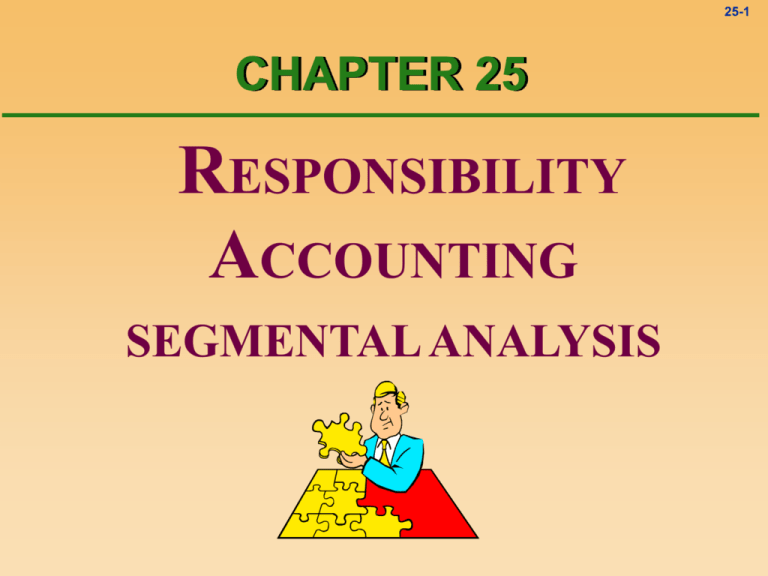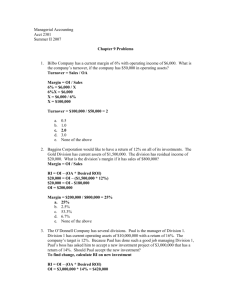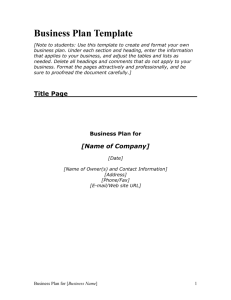CHAPTER 25
advertisement

25-1 CHAPTER 25 RESPONSIBILITY ACCOUNTING SEGMENTAL ANALYSIS 25-2 Responsibility Accounting Def. - An accounting system that collects, summarizes and reports accounting data relating to responsibilities of individual managers. It enables evaluation of managers by analyzing how well they manage those items under their control. Therefore, responsibility reports should concentrate on controllable items. 25-3 Responsibility Accounting Successful implementation of the system depends on proper organization so that responsibility is assignable to individual managers. Formal lines of authority and responsibility should be fully defined. Organization charts such as the following are used as a basis for responsibility reporting. 25-4 Organization Chart Board of Directors President Vice President of Finance Vice President of Operations Store Manager Department Manager Vice President of Marketing 25-5 Responsibility Reports Less detail Board of Directors President Vice President of Finance More detail Vice President of Operations Store Manager Department Manager Vice President of Marketing 25-6 889 Responsibility Reports Amount of detail varies according to level in organization. Department manager receives detailed report. Store manager receives summarized information from each department. Vice president of operations receives summarized information from each store. Management by exception (again) A given level of management does not receive detail from lower levels unless needed. e.g., VP could get store manager’s report 25-7 Responsibility Reports Responsibility reports should . . . Be timely. Be issued regularly. Be simple and easy to read. Compare budgeted and actual amounts. 25-8 Segments A segment is any part or activity of an organization about which a manager seeks cost, revenue, or profit data. A segment can be . . . A Sales Territory 25-9 Segments A segment is any part or activity of an Quick Mart organization about which a manager seeks cost, revenue, or profit An Individual Store data. A segment can be . . . 25-10 Segments A segment is any part or activity of an organization about which a manager seeks cost, revenue, or profit data. A segment can be . . . A Department 25-11 Segments A segment is any part or activity of an organization about which a manager seeks cost, revenue, or profit data. A segment can be . . . A Product Line 25-12 Responsibility Centers A responsibility center is a segment of an organization for which a particular manager is responsible. 25-13 Responsibility Centers Three Types of Centers Expense (or Cost) Centers Profit Centers Investment Centers 25-14 Expense/Cost Centers Incur expenses only Produce no direct revenue from sale of goods or services Manager held responsible for long-run minimization of expenses Primary means of evaluation Standard costs Flexible budgets e.g., accounting department 25-15 Profit Centers Incur expenses and generate revenue Primary objective is profit maximization Manager is held responsible for expense control and revenue growth Primary means of evaluation Contribution margin Why are they so appealing? Management is often paid based on how well their profit center performs. 25-16 Investment Centers What do they have besides expenses and revenues? An appropriate investment base Objective is to maximize return on that investment base Primary means of evaluation Return on investment (ROI) A/K/A Rate of Return Residual Income 25-17 Transfer Prices Buying Segment Selling Segment The price used to record a transfer of goods or services from one segment to another segment within the same company. 25-18 Transfer Prices Buying Segment Selling Segment Cost or expense Revenue What is the primary use for transfer pricing? Allows turning a cost center into a profit center. 25-19 Transfer Prices Buying Segment Selling Segment Cost or expense Revenue Lower price is desired. Higher price is desired. Potential conflict 25-20 Transfer Prices Buying Segment Selling Segment Cost or expense Revenue Lower price is desired. Higher price is desired. The transfer price can be . . . Market price if external market exists Cost to produce plus a profit margin Negotiated amount 25-21 Transfer Prices Buying Segment Selling Segment Cost or expense Revenue Lower price is desired. Higher price is desired. Setting prices is a big problem in practice. Management, marketing and finance courses also cover transfer pricing. Each discipline thinks it “owns” the problem. 25-22 Segmental Analysis Def. - Analyzing financial information by segment Uses concepts previously studied Fixed and variable costs Contribution margin, net income, etc. And new concepts Cost objective Direct cost Indirect cost 25-23 Segmental Analysis Concepts Cost Objective Cost objective The segment or product for which costs may be accumulated i.e., a scheme for collecting costs KEY - Costs are either direct or indirect relative to a particular cost objective. 25-24 Segmental Analysis Concepts Direct Costs Specifically traceable to a given cost objective Likely to be eliminated if cost objective eliminated Often controllable by segment manager Examples Cost accountant’s salary at Little Rock plant is a direct cost for that plant/cost objective Corp. accountant’s salary is direct cost to NY accounting department/cost objective 25-25 Segmental Analysis Concepts Indirect Costs Allocated to a cost objective and not specifically traceable to that objective Not likely to be eliminated if cost objective eliminated Often not controllable by segment manager Example Corporate accountant’s salary and the rent on NY home office are indirect relative to the three plants/cost objectives 25-26 Segmental Analysis Concepts Direct and Indirect Costs Therefore, costs may be direct to one cost objective and indirect to another. Another example: Segment manager’s salary is direct to the segment but indirect to the units of product made in that segment. Caveat - Some direct costs may not be controllable by the segment manager. Example: Segment manager’s salary is direct to segment but not controlled by the segment manager. 25-27 Segmental Analysis Example Total Company has two divisions. Total Company Radio Division Television Division 25-28 Segmental Analysis Example Contribution Margin Format Income Statement Before Segmenting into Divisions Total Company Sales $ 700,000 Less: Variable expenses 300,000 Contribution margin 400,000 Less: Direct fixed expenses 190,000 Contribution to indirect expenses 210,000 Less: Indirect fixed expenses Income 60,000 $ 150,000 TV Division Radio Division 25-29 Segmental Analysis Example Contribution Margin Format Income Statement After Segmenting into Divisions Total Company Sales $ 700,000 Less: Variable expenses 300,000 Contribution margin 400,000 Less: Direct fixed expenses 190,000 Contribution to indirect expenses 210,000 Less: Indirect fixed expenses Income TV Division $ 500,000 200,000 300,000 170,000 $ 130,000 60,000 $ 150,000 Indirect expenses are not attributable to either the TV or Radio Divisions. Radio Division $ 200,000 100,000 100,000 20,000 $ 80,000 Contribution Margin Format Income Statement Emphasizes a segment’s contribution to indirect expenses as appropriate figure for evaluating earnings of the segment. Expenses are classified as either . . . Variable or fixed Direct or indirect Companies may choose to allocate or not to allocate indirect fixed expenses. Authors’ preference? 25-30 25-31 Direct and Indirect Costs Fixed costs that are direct on one segmented statement can become indirect if the segment is divided into smaller segments. Let’s see how this works! 25-32 Segmental Analysis Example Organizational Segments Organizational Segments Television Division Black & White U. S. Sales Foreign Sales Color U. S. Sales Foreign Sales 25-33 Segmental Analysis Example Contribution Margin Format Income Statement Before Segmenting TV Division into Product Lines TV Division Sales $ 500,000 Less: Variable expenses 200,000 Contribution margin 300,000 Less: Direct fixed expenses 140,000 Contribution to indirect expenses 160,000 Less: Indirect fixed expenses 30,000 Income $ 130,000 Color Black and White TV Division’s $170,000 direct fixed expenses becomes $140,000 with additional segmentation. $30,000 is indirect to product lines. 25-34 Segmental Analysis Example Contribution Margin Format Income Statement Before Segmenting TV Division into Product Lines TV Division Sales $ 500,000 Less: Variable expenses 200,000 Contribution margin 300,000 Less: Direct fixed expenses 140,000 Contribution to indirect expenses 160,000 Less: Indirect fixed expenses 30,000 Income $ 130,000 Direct to products Indirect to products Total $ 140,000 30,000 $ 170,000 Color Black and White $170,000 is direct to TV Division. 25-35 Segmental Analysis Example Contribution Margin Format Income Statement After Segmenting TV Division into Product Lines TV Division Sales $ 500,000 Less: Variable expenses 200,000 Contribution margin 300,000 Less: Direct fixed expenses 140,000 Contribution to indirect expenses 160,000 Less: Indirect fixed expenses 30,000 Income $ 130,000 Direct to products Indirect to products Total $ 140,000 30,000 $ 170,000 Color $ 350,000 120,000 230,000 90,000 $ 140,000 Black and White $ 150,000 80,000 70,000 50,000 $ 20,000 $170,000 is direct to TV Division. 25-36 Are you ready for investment center analysis? 25-37 Investment Center Analysis Return on Investment ROI = Income Investment Return on investment (ROI) provides a relative measure of effectiveness of segments. ROI calculates the return (income) as a percentage of assets employed (investment). Skipped in Chapter 17 - Must know now! 25-38 Investment Center Analysis Return on Investment ROI may be used to evaluate different levels of investment centers in a company. (ILL. 25.7, p. 896) Evaluation of earnings of an entire company Evaluation of the income contribution of a segment Evaluation of income performance of a segment manager Therefore, “Income” and “Investment” can be defined any of three ways. Evaluation of Earnings of Entire Company When evaluating an entire company . . . “Income” in ROI formula is net income of company. “Investment” in ROI formula is total assets of entire company. 25-39 Evaluation of Income Contribution of Segment When evaluating a segment . . . “Income” in ROI formula is contribution to indirect expenses. “Investment” in ROI formula is assets directly used by and identified with the segment. 25-40 Evaluation of Performance of Segment Manager When evaluating a segment manager . . . “Income” in ROI formula is income that is controllable by segment manager. Begin with contribution to indirect expenses and eliminate any revenues and expenses not under the direct control of segment manager. “Investment” is assets under the control of the segment manager. 25-41 25-42 Expanded Form of ROI Calculation ROI = Income Sales × Margin or Return on Sales Sales Investment Turnover The ROI formula is expanded into two ratios to more easily demonstrate actions that might be taken to increase ROI. 25-43 ROI Question Regal Company has sales of $500,000, income of $30,000 and investment in assets of $200,000. What is Regal’s margin (return on sales)? a. 6% b. 10% c. 12% d. 15% 25-44 ROI Question Regal Company has sales of $500,000, income of $30,000 and investment in assets of $200,000. What is Regal’s margin (return on sales)? a. 6% Margin = $30,000 ÷ $500,000 = 6% b. 10% c. 12% d. 15% 25-45 ROI Question Regal Company has sales of $500,000, income of $30,000 and investment in assets of $200,000. What is Regal’s turnover? a. b. c. d. 2.0 times 2.5 times 3.0 times 3.5 times 25-46 ROI Question Regal Company has sales of $500,000, income of $30,000 and investment in assets of $200,000. What is Regal’s turnover? a. b. c. d. Turnover = 2.0 times 2.5 times 3.0 times 3.5 times $500,000 ÷ $200,000 = 2.5 times 25-47 ROI Question Regal Company has sales of $500,000, income of $30,000 and investment in assets of $200,000. What is Regal’s ROI? a. 6% b. 10% c. 12% d. 15% 25-48 ROI Question Regal Company has sales of $500,000, income of $30,000 and investment in assets of $200,000. What is Regal’s ROI? a. 6% b. 10% c. 12% d. 15% ROI = Margin × Turnover ROI = 6% × 2.5 = 15% 25-49 Problems With ROI Measuring Investment in Assets Three Ways To Measure Investment Original cost Original cost less accumulated depreciation (i.e., book value) Current replacement cost 25-50 Problems With ROI Suboptimization Def. - Segment manager takes action in segment’s best interest, but not in best interest of company as a whole. To deal with suboptimization, companies sometimes use Residual Income (RI). Residual income is the amount of income a segment has in excess of a desired minimum ROI. 25-51 Problems With ROI Suboptimization Example You are a division manager with an annual salary of $50,000 plus a bonus of $10,000 for each one percent that your division ROI exceeds company ROI. Your division ROI is 30 percent while the company ROI is 15 percent. What is your current total annual pay? Salary Bonus = $10,000 × (30 - 15) = Total annual pay $ 50,000 150,000 $ 200,000 25-52 Problems With ROI Suboptimization Example You are a division manager with an annual salary of $50,000 plus a bonus of $10,000 for each one percent that your division ROI exceeds company ROI. Your division ROI is 30 percent while the company ROI is 15 percent. A new project is available with an ROI of 24 percent. Based on your compensation plan, would you accept the project? 25-53 Problems With ROI Suboptimization Example As division manager, I wouldn’t invest in that project because it would lower my pay! 25-54 Problems With ROI Suboptimization Example Hmm . . . I thought we were supposed to do what was best for the company! 25-55 Residual Income To deal with suboptimization of this type, let’s use residual income (RI). RI = Income – (Investment × Minimum ROI) 25-56 Residual Income Question A division has a $100,000 investment in assets and a company minimum ROI of 20 percent. If income for the division is $30,000, what is residual income? a. b. c. d. $30,000 $20,000 $10,000 $0 25-57 Residual Income Question A division has a $100,000 investment in assets and a company minimum ROI of 20 percent. If income for the division is $30,000, what is residual income? a. b. c. d. $30,000 $20,000 $10,000 $0 Income $ 30,000 Minimum Required Return ($100,000 × 20%) 20,000 Residual Income $ 10,000 25-58 Motivation and Residual Income Using residual income to evaluate managers encourages them to make profitable investments that would be rejected by managers evaluated using ROI only. 25-59 Motivation and Residual Income My residual income is rising even though average ROI is declining! 25-60 THE END I’ll teach you a thing or two about responsibility and authority in my organization!









